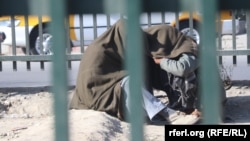KANDAHAR, Afghanistan – Most days Sardar Wali, a young Afghan farmer in his 20s, does little.
He is addicted to heroin, the deadly drug derived from illicit opium that farmers like Wali produce in such abundance that for nearly decades Afghanistan has remained the world’s leading opium producer.
As he inhales heroine through a paper roll from the top of tinfoil heated by a match underneath, Wali reflects on his misery.
“The drugs are cheap and sold everywhere, even in remote villages,” he told Radio Free Afghanistan. “We plant opium poppies here and then heroin is processed from it, which is then sold locally.”
Even Wali is worried over the exploding addiction rates in Nagahan, an idyllic village in rural Arghandab district, which border Kandahar city, the capital of a large southern Afghan province of the same name. Arghandab is famous for its grapes and pomegranates, but many farmers have switched to opium poppies.
“If the government had declared a crackdown on drug dealers and the military and police commanders, tribal leaders and members of local councils would not allow them to operate, and the situation here would have been much different,” he said.
Addiction rates in Afghanistan’s conservative rural areas such as Kandahar are rising rapidly because cheap drugs are easily available as authorities do little to control soaring domestic drug use.
Since 2001, narcotics addiction rates have skyrocketed across Afghanistan. By 2009, one in 12 Afghans suffered from drug habits, according to the United Nations. Today more than 3.6 million Afghans or more than 11 percent of the country’s estimated 30 million population are drug addicts. Most drug addicts live in the country’s tens of thousands of villages.
Abdul Rashid, another drug addict in Nagahan, says the communities need to rid themselves of Saqis – a local term for drug peddlers. “If they continue to operate freely, five people can get addicted daily,” he told Radio Free Afghanistan. “This number can quickly jump to 500 if nothing is done.”
Haji Abdul Ahad, a tribal leader in Arghandab, however, says that combatting drug addiction requires a robust national effort.
“We need to eradicate and ban poppy cultivation and destroy the makeshift labs where heroin is cooked,” he told Radio Free Afghanistan. “Then it will be difficult to buy or sell drugs, and the addicts will have no choice but to give up their habits.”
Security officials in Kandahar are adamant that battling drugs is already a top government priority. “We are ready to nab drug dealers or those involved in producing it,” Kandahar Police spokesman Zia Durrani told Radio Free Afghanistan. “We, however, need constant cooperation from our people.”
But the unemployed youth in Afghanistan remain extremely vulnerable.
In Nagahan, Wali sees little hope. “Everybody knows the problem, but few are ready to address it,” he said.
Abubakar Siddique wrote this story based on Mohammad Sadiq Rashtinai’s reporting from Kandahar, Afghanistan.






